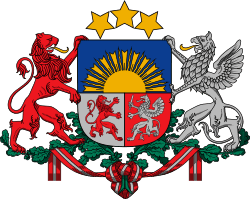Latvian Diplomatic Service
| Latvian Diplomatic Service | ||||||||||
| Latvijas Diplomātiskais serviss | ||||||||||
| Government-in-exile | ||||||||||
| ||||||||||
| ||||||||||
| Capital | Riga (de jure) | |||||||||
| Capital-in-exile | London Washington, D.C. | |||||||||
| Government | Transitional government | |||||||||
| Historical era | Cold War | |||||||||
| • | Established | June 1940 | ||||||||
| • | Latvian Independence | 21 August 1991 | ||||||||
| ||||||||||
| Part of a series of articles on the |
| Occupation of the Baltic states |
|---|
 |
|
|
|
Estonia
Latvia Lithuania |
The Latvian Diplomatic Service maintained representation of independent Latvia during the Soviet occupation of their homeland (1940–1991).
Latvia was occupied on June 17, 1940 by Red Army troops and officially annexed to the Soviet Union on August 5, 1940. But the United States never recognized the forcible and illegal annexation of the Baltic States in conformity with the principles of the Stimson Doctrine (US Under Secretary of State Sumner Welles`s Declaration of July 23, 1940), and more than 50 countries followed this position. The Republic of Latvia, from 1940 through 1991, continued to exist as a state de jure according to international law during the whole period of its actual occupation and annexation. Therefore, some Latvian diplomatic and consular representations continued to function from 1940 through 1991 in some Western countries (United States, Australia, UK etc.), dealing with a limited part of state functions of the Republic of Latvia.
The diplomatic service of the Republic of Latvia, as the sole institution of its executive power, continued its limited range of activities abroad for about 50 years. In July and August 1940, Latvian envoys who continued to be accredited to the USA and UK governments made official protests against Soviet occupation and annexation of their country. This Service met many difficulties due to the lack of a legal government in its homeland. Members of the Latvian diplomatic service in Western countries continued to formulate and express the official opinion of the Republic of Latvia, and protected the interests of Latvia and their citizens abroad throughout these 50 years. Latvia was not allowed to establish a government-in-exile in any Western country or sign the Declaration of the United Nations (1942), as Latvian diplomats wished.
The Heads of the Latvian Diplomatic Service were: Kārlis Zariņš (Charles Zarine) (1940–1963), Arnolds Spekke (1963–1970), and Anatols Dinbergs (1971–1991). The main directions of activities of the Service were: protection of rights and property of the Republic of Latvia and its citizens abroad (including consular issues), regular reminders to the international community as to legal rights of the Latvian nation to regain its independence, etc.
In 1969 Latvian Counselor to the US Anatols Dinbergs signed on behalf of the Latvian nation among leaders of 73 countries around the world the Apollo 11 Goodwill Messages.[1]
While the homeland was under the rule of occupation authorities, the Service gained some new and, in comparison with de facto independent countries, different experience in diplomatic work and thus advanced the complete restoration of Latvia's independence in 1991. As mentioned above, the specific character of the Latvian foreign service activities is a real affirmation of the situation that the Republic of Latvia continued its existence de jure, and many countries never considered its annexation by the Soviet Union to be lawful and just.
After Latvia's parliament declared the end of a "transitional period" and claimed de facto full independence on August 21, 1991 in the aftermath of the failed Soviet coup attempt, and wide international recognition of restored independence started, the legations and consulates of the Diplomatic Service were transferred to the Latvian Ministry of Foreign Affairs. Anatols Dinbergs, a diplomat who had served his country for almost 60 years, was promoted to the rank of Ambassador and Permanent Representative to the United Nations (September - December 1991) as well as Ambassador to the USA (1991–1992).

